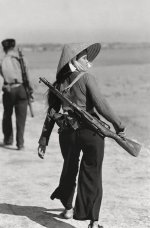Frank, in your experience instructing new shooters, are there certain firearm types that make learning proper and safe use more difficult or are all types about the same? Does recoil play a factor for students new to firearms?
As to types of firearms, what's important is that the gun be within the student's physical abilities. Heavy or large handguns can be a problem for folks with small hands or limited hand strength. Guns with very stiff controls/springs can also be an issue.
With long guns, again fit can be an issue. Too long or too short a length of pull on a shotgun can make that gun unsuitable for a particular student. And students with limited upper body strength can have trouble with a 12 gauge, especially pump action.
Many of these problems go away with time, training and practice. But thing like an excessive trigger reach or too long a stock are consistent limiting factors.
Recoil is certainly an issue as well. Heavy recoil is hard to manage for beginners. It's also a turn-off and interferes with their ability to concentrate and focus on the fundamentals. Subjecting a raw beginner to a physical pounding is not a good way to start them off.
However, in our handgun class we use a step-by-step, measured and supportive approach. We do a lot of "hands-on" work with the students. The students handle a variety of revolvers and semi-autos under direct supervision, one-on-one, of an instructor. They use dummy rounds to load and unload the guns, dry fire and generally learn how things work and feel, and they get continual safety reinforcement. These initial hands-on exercises help students get familiar with handling guns and lay a foundation for safe gun handling habits.
Then in preparation for live fire, and after the "marksmanship" lecture, we work one-on-one with students on grip and stance using "blue" inert training guns. Before going to live fire with .22s, the students shoot airsoft (the quality type) in the classroom. After that the students fire 25 rounds of .22 (working one-on-one with an instructor).
Then we put out a variety of guns from 9mm to .44 Magnum so the students can get the experience of firing the larger calibers. Shooting the centerfire guns is at each student's option. Most fire them all, but some choose not to. When someone has gone through our program, it's not uncommon for her/him to be shooting 1.5 to 2.0 inch groups at seven yards with the heavy calibers. A few months ago, a petite young woman who had never fired any type of gun before out shot everyone, including her husband, with the .44 Magnum -- putting three rounds into about an inch at 7 yards. In fact, many women especially have a great time with the .44 Magnum.
The keys are, I think, plenty of hands-on one-to-one work and a progressive, step-by-step approach with each step laying a good foundation for the next.

